Introduction to White Light
If you can’t see your target, you can’t (and shouldn’t) pull the trigger on it. Unfortunately, many firearms enthusiasts underestimate one of the most important features of their kit: their flashlight.
When something goes bump in the night, or when you’re out in the heavy rain, your flashlight is the first line of defense. Whether it’s a handheld or a full-powered rifle light, your white light is key to controlling space in a dark environment.
The good news? You don’t have to break the bank to get a great tactical weapon light. In this guide, we’ll detail the critical benefits of flashlights, identify key terminology, and compare the most popular flashlights on the market.
Here is a reference table of all the Weapon Lights discussed in the Article. Click on any of them to view them in our store.
Without further ado, let’s talk benefits.
Why Use a Weapon Light?
While there are countless applications of white light, three benefits stand out when discussing personal protection.
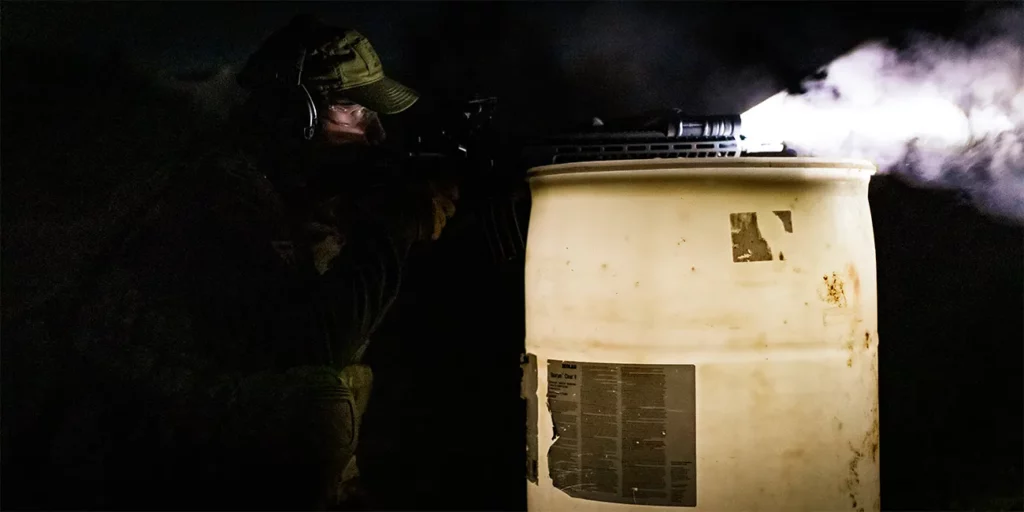
Visibility (Including through smoke/rain/obstruction)
First, a strong flashlight is 100% necessary in viewing and engaging targets through darkness, rain, or other translucent obstruction. This feature might seem obvious—but it’s actually underrated, and here’s why:
Muzzle smoke.
If you fire a pistol or rifle indoors, you create a substantial fog. In daylight or bright ambient light, this fog might not affect your visibility, but if you layer smoke on top of darkness or rain, you’ll find it near impossible to see through the haze.
Muzzle smoke is no joke. No flash hider or brake can mitigate it. Only a high-output flashlight can break through the cloud and bring your target back into view.
In short, weapon lights let you identify targets in dark conditions, and they help you maintain visibility through obstruction.
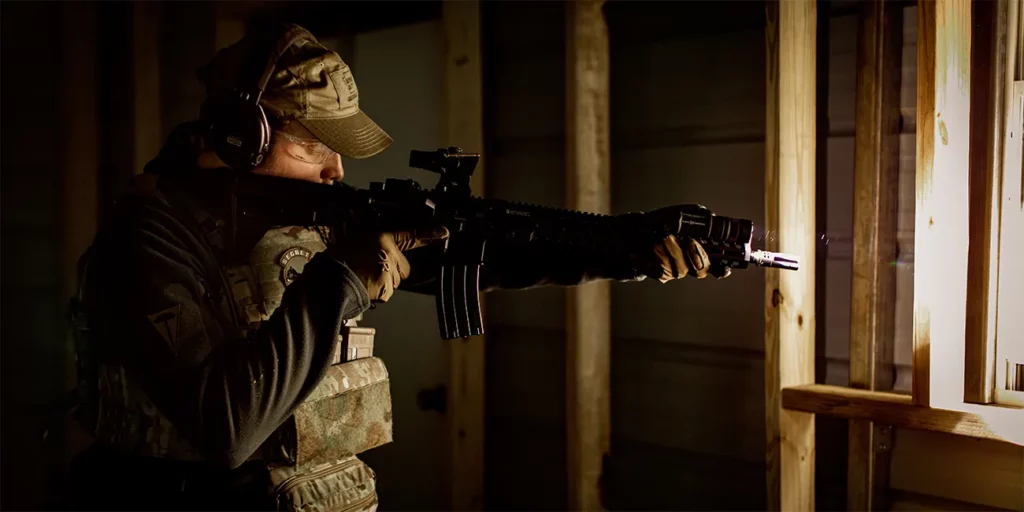
Control the Opposition
Flashlights aren’t just for your own visibility.
They also deny vision on the other side, and that’s a powerful first-line deterrent to foolish behavior.
Police officers know how compelling (and disorienting) a bright light can be. That’s why officers deploy floodlights or high-output hand lights to blind suspects before the takedown. Resistance is a challenge when you can’t see your opposition.
The same effect should be used in home-defense scenarios. Never rely on your house’s ambient light to scare a trespasser. At best, overhead lights might startle an intruder. At worst, the intruder will know your exact position as you move through your house. A flashlight allows you to control your opposition without risking self-exposure.
Oh, and don’t fall for the ‘you’ll blind yourself’ myth. With just a little bit of practice in the home, you’ll learn to how to avoid reflective surfaces. Plus, you can always point your weapon light up to give yourself pseudo-ambient light.
Overcoming Photonic Barriers
Here’s an important term to know: photonic barrier.
Photonic barrier describes the way a powerful light blocks vision beyond its source. Originally, this term described white light’s effect on the intensification tubes found in night vision devices, but human eyes are sensitive to the same effect.
To understand a photonic barrier, imagine this:
You’re driving along a 2-lane road. There’s another car approaching from the opposite direction. Unfortunately, the other driver is jamming out to Zeppelin with his high-beams on.
As you approach, the powerful light from his headlights makes it impossible to distinguish the details of his car. Even though you aren’t blinded, the headlights are concealing the vehicle by proximity. You cannot see the driver or his passengers until you drive past him. This is the photonic barrier.
When it comes to a beating a photonic barrier, lumens are great, but candela is king.
And here’s why…
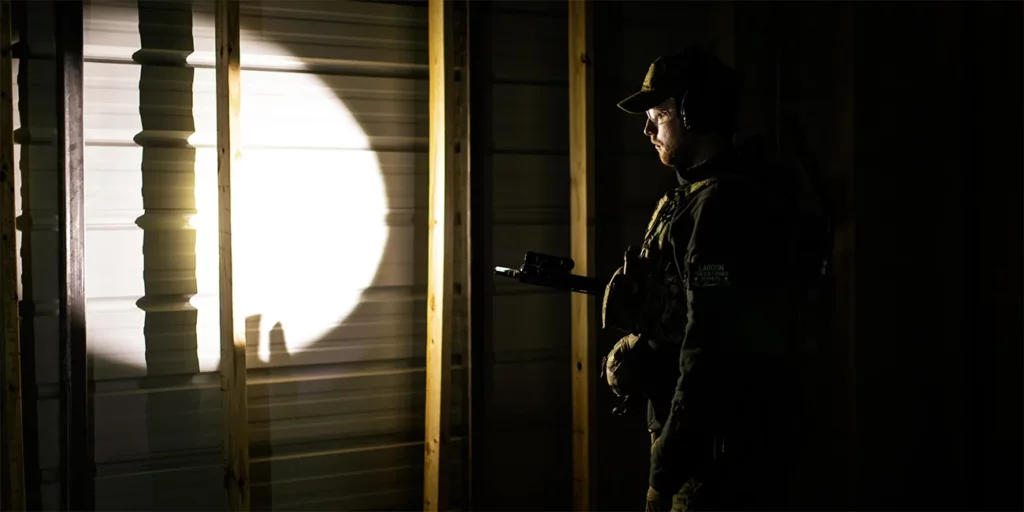
Key terms and evaluation:
When we talk about flashlights, there are a few important terms and concepts to know.
Lumen, candela, and lux are three measures of a light’s output, but they’re all slightly different. We also refer to a beam by its spill and throw, and some lights are differentiated by momentary activation, constant activation, and strobe. You might also see talk about method of activation, whether it’s a button, a lever switch, or a tape switch.
If these terms are new to you, read up on them below. Once you know the basic verbiage, you can sus out the qualities of a product just by its description.
Lumens/Candela/Lux
Lumens are a metric unit for luminous flux—or visible light emitted per unit of time. In practical terms, lumens measure a flashlight’s raw output. Lumens don’t say anything about the light’s intensity or beam pattern—just the sheer amount of light coming out the front. You always want more lumens, but lumens aren’t everything when picking a light. You must also consider the beam pattern, body size, and feature set.
Candela is a measure of luminous intensity or candlepower. Brighter lights will have a higher candela rating. Some weapon lights, such as the Modlite OKW, sacrifice lumens for the sake of having super high candela. Think of it like having a smaller hose, but a tighter nozzle. A high candela rating will make it easier to spot targets at long distances—or in denser obstruction. High candela lights fare better against photonic barriers.
Lux is another intensity measurement. Here’s the equation…
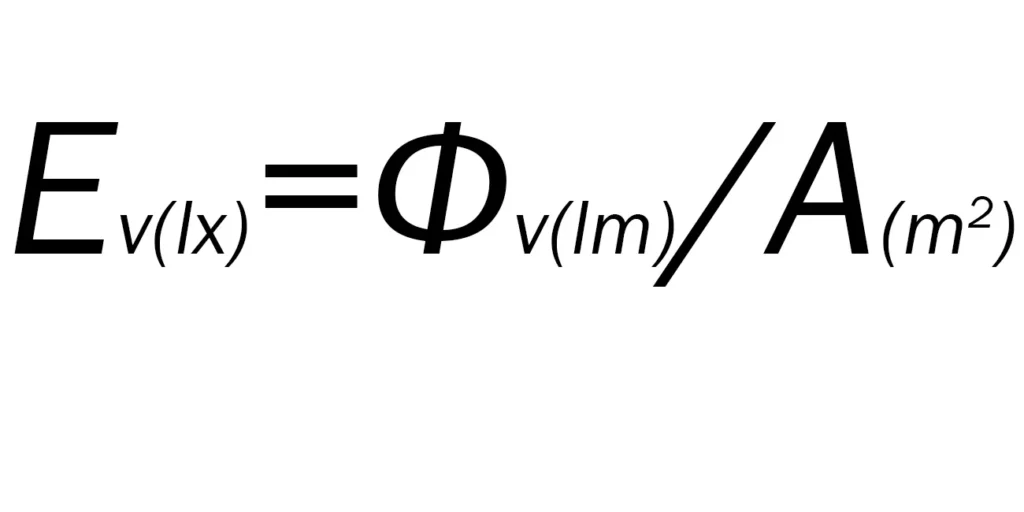
Haha. Just kidding. This is a cool gun blog.
Lux is like candela. It’s a measurement of intensity, representing lumens within a surface area at a set distance. If lux increases, it means you have more lumens concentrated inside a smaller surface area, creating a more intense beam.
We recommend sticking to candela and lumens when drawing comparisons, since these numbers are more commonly used.
Spill and Throw
These terms describe the characteristics of a flashlight’s projected beam.
Spill, sometimes called Flood, refers to the width of a beam. A light with a lot of spill will project a very wide beam, illuminating more of the periphery. Lights with low candela and high lumens like the Surefire M600DF offer the greatest amount of spill. For close-quarters use, a high-spill light is invaluable, as a wider beam can fill a room instantaneously.
On the other end, throwOn the other end, throw is the distance that the beam will project. Lights with high candela ratings will have greater throw, sometimes at the cost of spill. Lumens being equal, there’s usually an inverse relationship between spill and throw. As previously mentioned, the Modlite OKW’s 69,000 candela give it best-in-class throw, making it perfect for outdoor use.
Modlite Systems OKW-18650 Complete Light View Details
Hot Spot and Temperature
Another two terms to describe a light pattern: hot spot and temperature.
Your Hotspot is the center point of the light beam, where it is most bright. Most weapon lights will have a definitive circle of light in the middle of their beam, which is significantly brighter than the surrounding light. This is where you’ll have your highest candela rating, so it’ll have a further throw than the peripheral illumination
TemperatureTemperature describes the natural color of the light. Every light has a ‘temperature’, ranging from pale white to a warming yellow. Your light’s temperature will affect your ability to differentiate color in the beam though, where non-neutral light will dye the world with the beam’s tint.
Momentary vs. Constant vs. Strobe
Every flashlight has an activation mode, whether it’s momentary only, constant-on, or a strobe effect.
Momentary lights will only be active while you’re pushing the switch. Momentary lights are great for brief illumination, which is tactically advantageous, as it allows identification without compromising one’s own position.
Constant-on lights are just that. You hit the switch and it stays on until you click it again. This is a lot less strenuous on the thumb than a momentary light, but you must be mindful of your exposure. If you’re leaving your light on, everyone outside the beam will see your position before you see them.
Some lights have a Strobe activation, which causes the light to flicker in and out rapidly. In theory, a strobe will have a greater disorientation effect, but the risk is double-sided, as strobe lights can also dazzle the user. Ultimately, strobe is a neat feature, but it shouldn’t be a key decision factor.
Inforce WMLx Gen 2 Weapon Mounted Light – 800 Lumens View Details
Activation Method: Button/Lever/Tape Switch
Lights also have different buttons and controls to activate, including buttons, levers, and tape switches.
Buttons are the most common for rifle and handheld lights. You press a big rubbery button, and the light turns on. Simple.
For pistols lights, many devices use levers that straddle the front of the trigger guard. This allows the user to activate the light with their support hand or trigger finger as needed.
Finally, tape switches are a tool for rifle-mounted lights. A tape switch is a separate button that connects to the flashlight with a cable. By adding a tape switch to your rifle, you can position your flashlight near the muzzle, while the activation button sits comfortably in the center of the handguard.
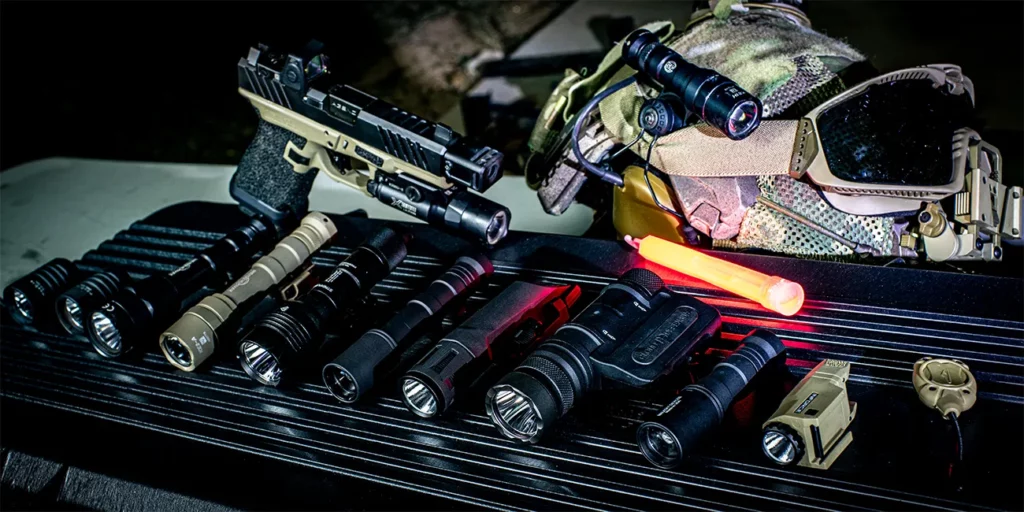
Types of Weapon Lights
Now that you’re well-versed in flashlight terminology, let’s talk about the most common types of tactical lights: handheld lights, rifle lights, and pistol lights.
Handheld Lights
The most important light in any toolkit, especially outside the home, where you can’t pull a gun on everything that moves in the dark.
As a first line of defense, a high-output handheld light will break through shadows without risking a brandishing charge. In many cases, handheld lights are just unmounted rifle lights. Many folks carry a SureFire Scout and simply detach the factory picatinny mount.
If you can only have one light, get a handheld. With proper training, you can use a handheld in conjunction with a firearm to get similar performance to a dedicated weaponlight.
Shop All Handheld Lights Buy Now
Rifle Mounted Weapon Lights
Rifle-mounted lights are a critical attachment on any personal defense carbine—especially one made for home defense. These lights are full-size and usually take CR123 or 18650 batteries for maximum output.
When mounting a light on a rifle, you will usually have several options, which position the flashlight in a more comfortable position. Arisaka Defense is known for their excellent offset mounts, as is Magpul and BCM. Your best light mount will ultimately depend on your handguard, your light’s mounting compatibility, and your personal preferences.
Many lights use the SureFire Scout-style mounting system. Modlite, Arisaka, and SureFire lights use the SureFire mounting system. They also have compatible tail caps, which means you can use the same tape switches. The SureFire tape switches have become industry standard, but the Unity TAPS is great if you need a durable dual switch for IR devices.
Pistol Lights
Pistol-mounted weapon lights fill a similar role as their larger rifle-mounted counterparts, except pistol lights need to be compact to fit in a holster. Nowadays, most holster manufacturers have options to fit the more popular pistol lights from SureFire, Inforce, and Streamlight.
Because pistol lights are so compact, many lights use an ambidextrous wing switch, which rides along the sides of the trigger guard. This design helps the user to control the activation with either their trigger finger or support hand.
Some pistol lights are equipped with an additional red or IR laser. If you’re doing night vision stuff, an IR laser is beneficial. The visible red laser is useful for close-quarters point shooting, but it’s important to remember that red lasers can expose your position, just like a flashlight can.
Shop Weapon Lights and Lasers Buy Now
Comparison:
Now for the side-by-sides.
A few weeks back, a few of us wandered out into the dark of night for a bit of after-hours marksmanship. While none of us were able to locate the Donkey Lady of San Antonio, we were able to capture a few images comparing a dozen of our most popular weaponlights.
To give you the best reference on beam pattern, we set up a few targets and barricades for contextual comparison. The two white silhouettes in the back are 100 yards out. The barricade, blue barrel, and white barrel are 50 yards out. The close barricade (seen on the right side) is about 25 yards out.
Note:Your screen brightness may affect your perception of the images. In some cases, images (especially pistol lights) may seem darker than reality.
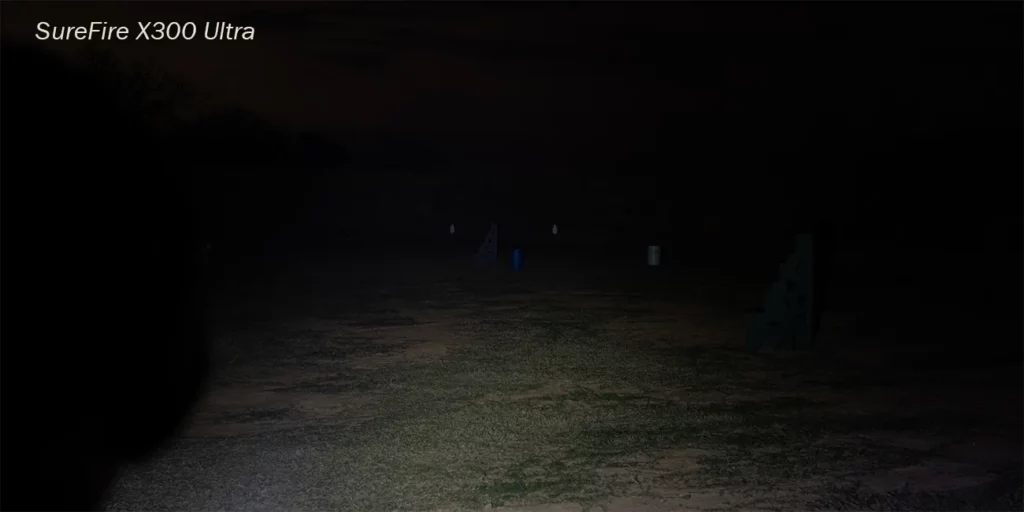
Surefire X300 Ultra
If you haven’t heard, the SureFire X300 Ultra is the bee’s knees when it comes to getting big lumens in a small package.
A blazing 1000-lumen beam extends your visibility out to the 100-yard line while maintaining a wide spill for peripheral targets. It’s heavy duty, rugged, and runs off a pair of CR123 batteries. With such impressive performance, it’s no wonder why you’ll find these lights on plenty of SOCOM sidearms.
Pros: 1000-lumen output. Super Rugged. Uses CR123 Batteries.
Cons: Heavier than other pistol lights. Pricy.
Compact Rifle Lights (CR123A Cells)
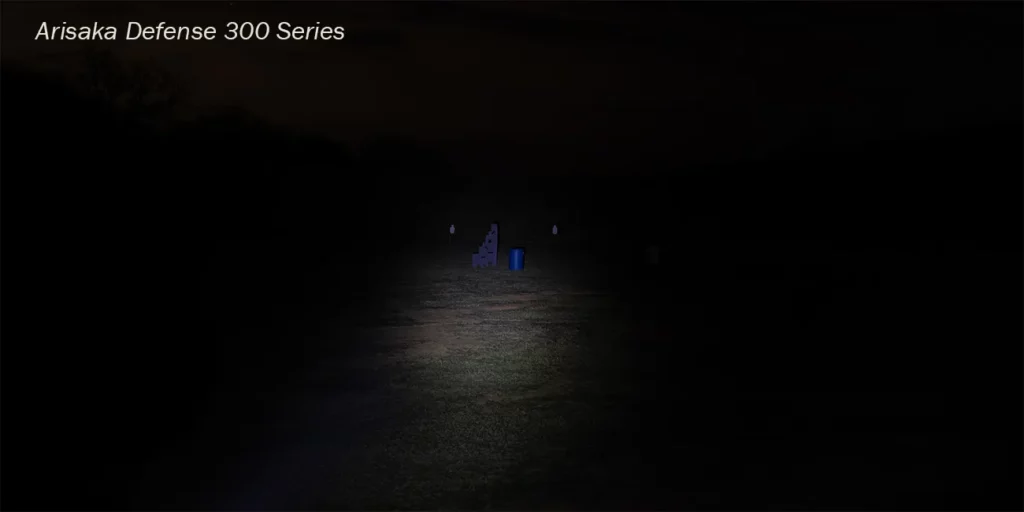
Arisaka Defense 300 Series
Our first compact rifle-mounted/handheld light is a great all-arounder.
The Arisaka 300 Series is a similar flashlight to the SureFire M300 featured next. Actually, they are functionally very, very similar—to the point that you can interchange tail caps, heads, and mounts. This gives the Arisaka lights a special benefit. Since these lights come piece-by-piece, you can tailor it exactly to your needs without spending extra. At 325 lumens, its output isn’t the highest, but the Malkoff head gives it 23,000 Candela, which is plenty bright to reach 100-yards.
Pros: Customizable. 2.8oz. Compatible with SureFire Scout M300 parts.
Cons: Less Output than the SureFire equivalent.
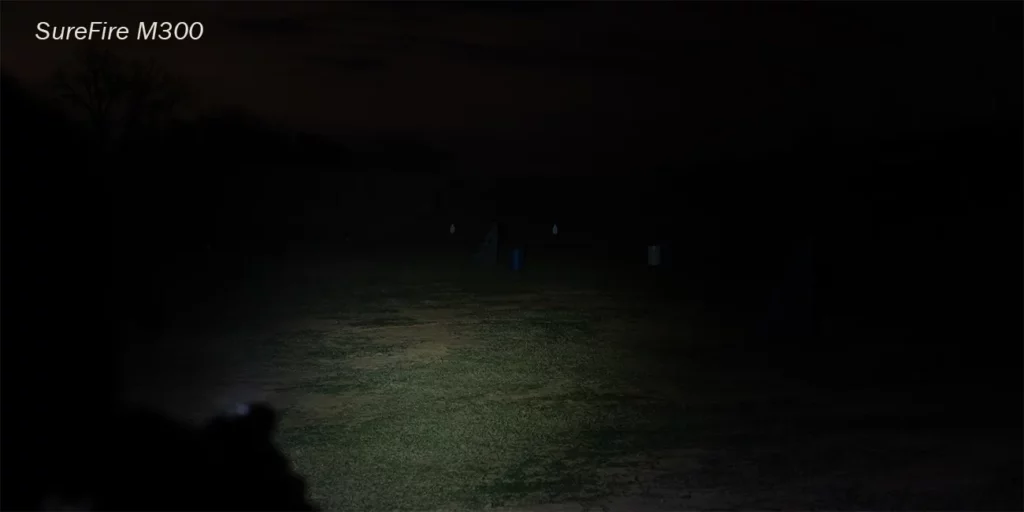
SureFire M300
A rugged, compact rifle light proven through field use.
Even with a 500-lumen output, the SureFire M300 Mini Scout is an admirable weapon light that can easily fit in the pocket as a handheld. The recoil-proof LED emitter is amplified with a TIR lens to get a great beam for close to medium range applications. For a PCC or compact AR, the M300 offers excellent performance in CQB without taking up much rail space. Plus, it’s compatible with all the SureFire Scout accessories and mounts, which are the most prevalent on the market.
Pros: Fits SureFire Scout Accessories. Ruggedized for Field Use. Small Footprint.
Cons: Still only 500 lumen output. Shorter throw.
Standard Rifle Lights (CR123Ax2 Cells)
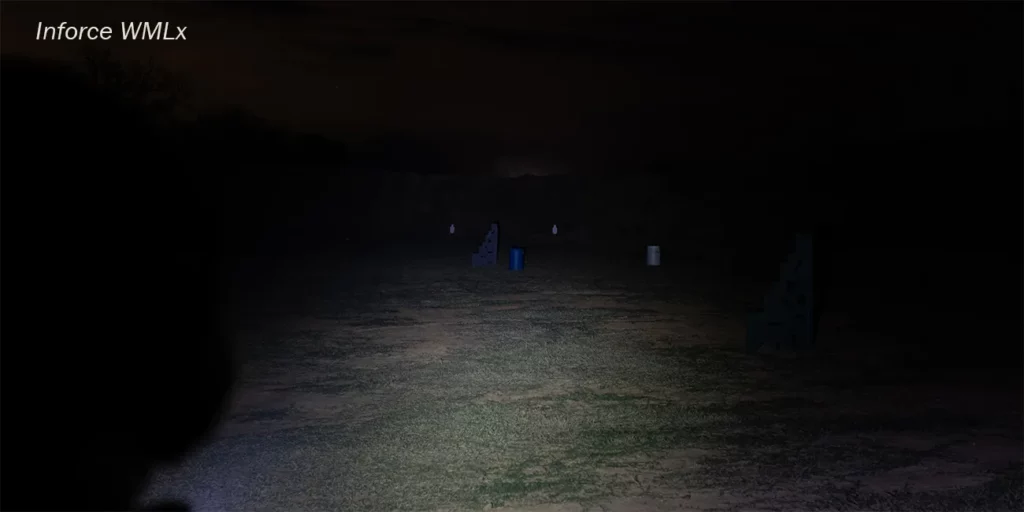
Inforce WMLx Gen 2 Weapon Light
An incredibly lightweight weaponlight with an impressive beam pattern!
The Inforce WMLx Gen 2 Weapon Light is a unique contender in its polymer construction. It’s the lightest option among its peers, but the WMLx is not slacking in the output department. With a wide spill, it doesn’t quite light up the 100-yard targets, but don’t let that fool you. This light is mostly spill, giving you greater detail at that 50-yard line with a wider hot spot. And not to harp on the weight, but… it’s only 4oz.
Pros: Excellent mid-range beam pattern. Super lightweight. Integrated push-button. Affordable.
Cons: Cannot take tape switches. Not as rugged as an aluminum-body light.
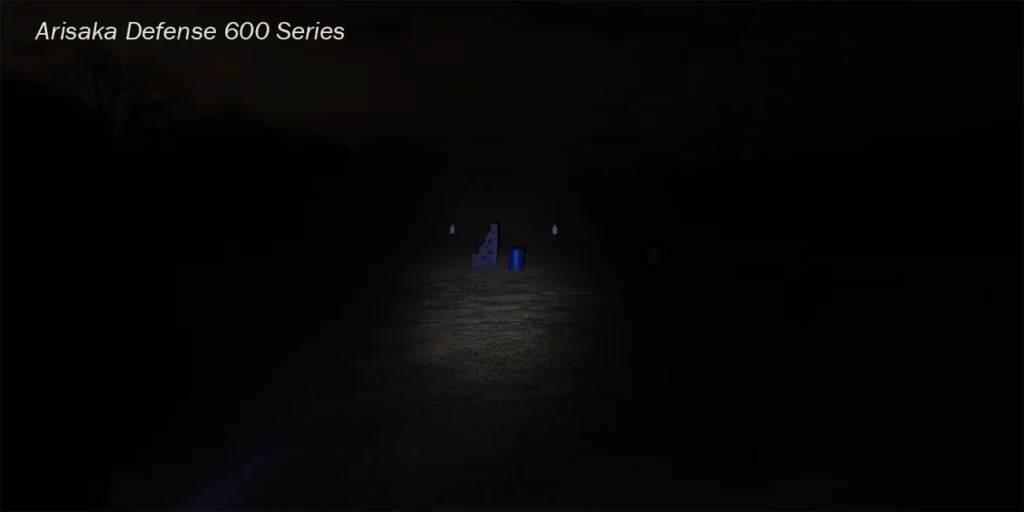
Arisaka Defense 600 Series
Everything great about the 300 series, but with more output!
The 600 series is Arisaka’s full-size scout light. It’ll be a little bit heavier than the 300 series, but not by much. The big benefit of the larger body is the ability to take 16650 or CR123 batteries for a tightly-focused 35,000 Candela output. With this light, you can make out some of the deeper details at 100 yards and beyond. Just like the 300 Series, this light is easily customized, as you can purchase it piece-by-piece.
Pros: Customizable. Good throw. Compatible with SureFire Scout M300 parts.
Cons: Less Output than the SureFire equivalent.
Surefire M600U
The workhorse weaponlight with fantastic throw and an unbeatable aftermarket.
The SureFire M600 Ultra Scout is not the highest output SureFire on this list when you go by lumens, but the beam pattern is perfectly balanced for a carbine. Not only do you get great spill for peripheral identification, but you get the clear details at 100 yards too. Combine this with the biggest aftermarket in the industry, and you have a clear winner for those looking at a generalist rifle light.
Shop All Surefire Weapon Lights Buy Now
Pros: 1000 Lumen output. Balanced beam pattern. Rich aftermarket for mounts and accessories.
Cons: Pricy.
High Output Rifle Lights (18650 Cells)
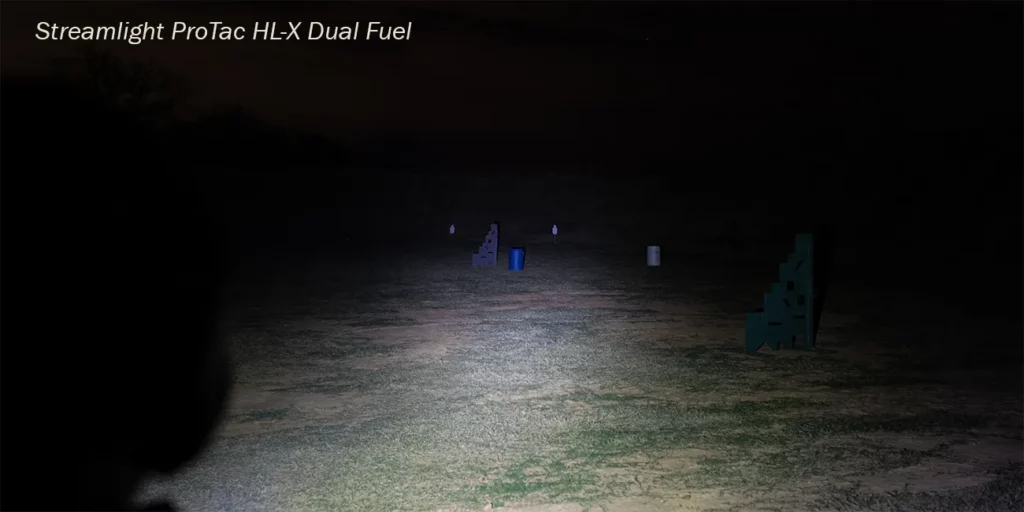
Streamlight ProTac HL-X 1000 Lumen Dual Fuel Flashlight
One of the best lights you can get for the money. Period.
With a $79-dollar price tag, this light might not sound like a heavy-hitter, but the proof is in the pictures. The HL-X is clearly one of the best values in weapon lights. With a user-selectable output, this light can keep up with the big dogs at maximum power, reaching out to 100 while fully illuminating the foreground with impressive spill. The light’s body is surprisingly rugged, so it should fare well in the field too. Plus, it uses SureFire Scout mounts, which are the most popular on the market. All-in-all, we’re impressed to say the very least.
Pros: 1000-lumen output with wide spill and 27,000 Candela. Rugged. Uses SureFire-style mounts. UNDER $100.
Cons: Cannot use SureFire-compatible heads. Can only use SureFire-style tail caps with an adapter.
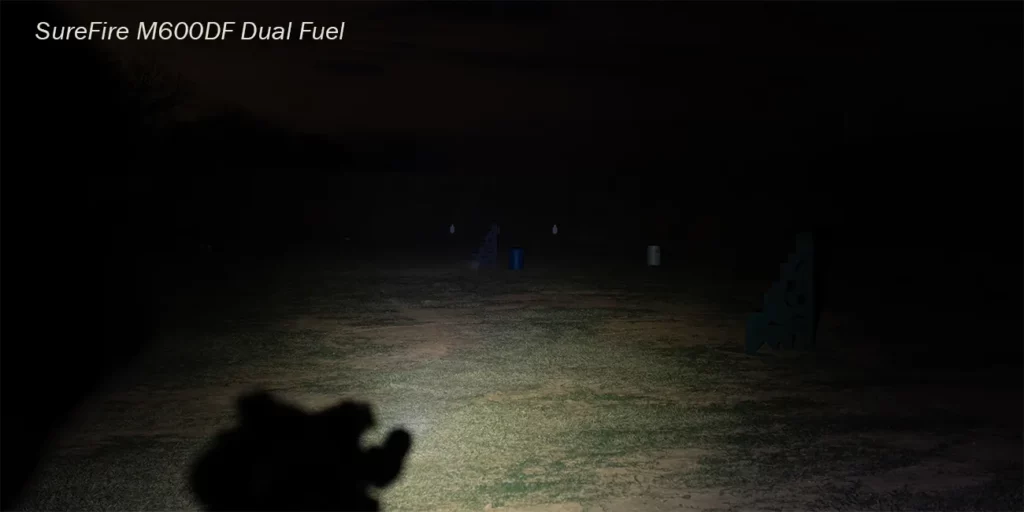
SureFire M600DF
The Dual Fuel Light that started it all.
SureFire’s M600 Dual Fuel is a light that changed the industry, allowing users to choose between 18650 cells and a pair of CR123s. With a 1500-lumen rating, this light has the highest raw output of any light on this list, but its candela rating is on the low end. The result is a warm light with a huge spill that totally illuminates the first 50-yards. Beyond that, you might want to consider switching heads to something tighter (such as the Modlite heads below!)
Pros: Compatible with SureFire Scout accessories. 1500-lumen output. Huge spill.
Cons: Low Candela. Pricy.
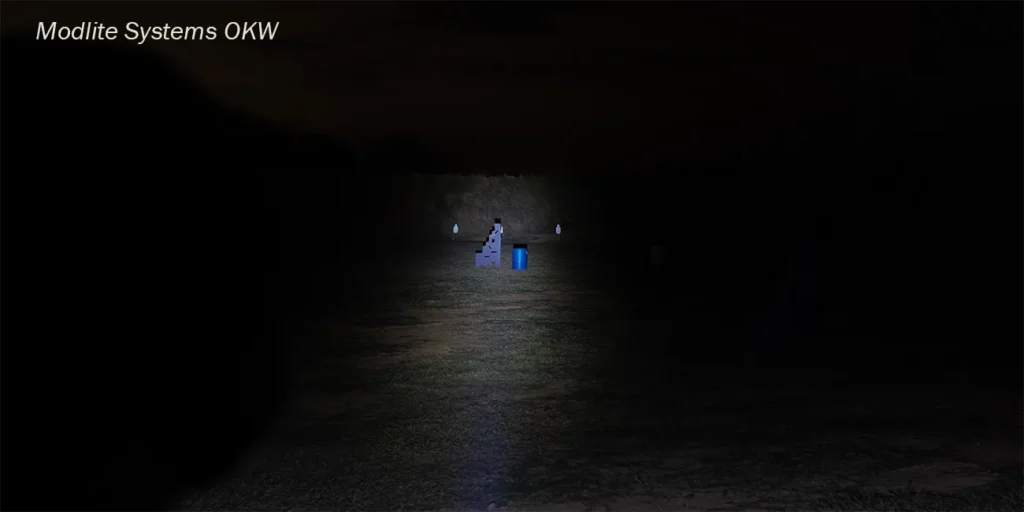
Modlite OKW
When you absolutely, positively need as much Candela as possible, nothing beats the OKW.
The OKW is a Modlite product that mirrors the SureFire M600DF pattern for parts compatibility. With the OKW head, the beam pattern tightens for minimal spill and maximum throw, ensuring that you see all the fine details at 100 yards andFAR beyond. Personally, this is my favorite light for an SPR or precision rifle. If you can afford the OKW, you really can’t go wrong.
Pros: Compatible with SureFire Scout Accessories. Head can be attached to existing SureFire M600DF. BIG CANDELA.
Cons: It’s basically all throw, if that’s a negative to you. Also, quite expensive.
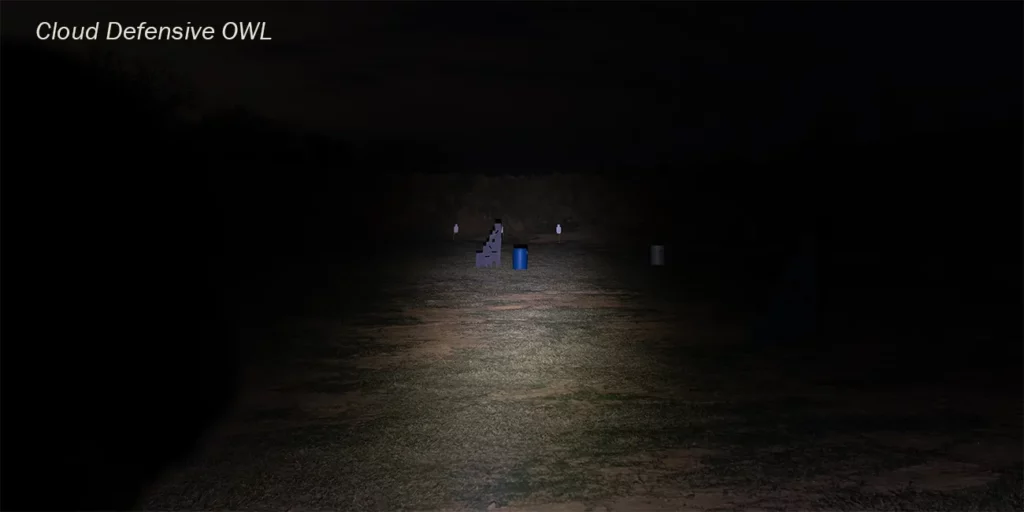
Cloud Defensive OWL
Big, bold, and blazingly bright. The OWL is possibly the best all-around rifle light anywhere.
What else can be said about Cloud Defensive’s Optimized Weapon Light. At 11oz, you notice its presence at the end of the rifle, but every bit of that weight is worth it. When you’re pointing the OWL downrange, its warm glow will make it seem like daytime, even at a distance. It’s hard to imagine anything could be more durable, as the OWL is clearly built to take the worst that battle can offer.
I’m pretty sure they threw the OWL into open waters to test its depth resistance. The light went 200ft down for 24 hours, and the pressure was so intense that the activation button was perpetually depressed. And yet the OWL lived on.
Shop all Cloud Defense Lights Buy Now
Pros: Possibly the most durable weaponlight ever made. Incredible beam pattern and temperature. Integrated switch mount for ideal thumb placement.
Cons: Expensive. Big. Heavy. Somewhat limited mounting options.
Conclusion
In this article, we’ve covered all the basics of flashlights and tactical illumination. Until you’re slinging Night Vision and Full-Power IR, your flashlight is critical for low-light superiority.
If you’ve got any additional questions about the concepts in this guide—or if you want to learn more about the lights that we tested—reach out to us using the chat button on the righthand side of the screen. Our specialists are well-versed in the technical aspects of flashlights, and they’ll be able to help you figure out your exact needs. Alternatively, you can hit us up on social media—we’re pretty quick to reply.




